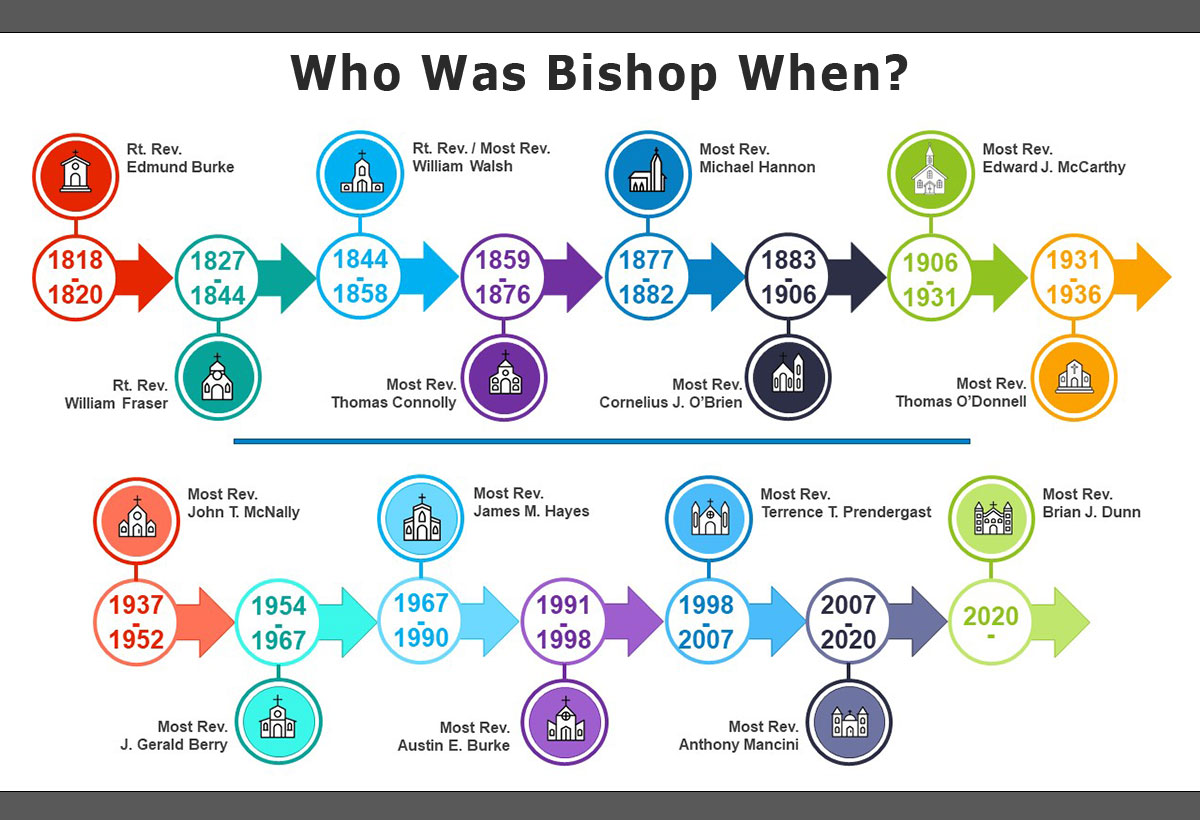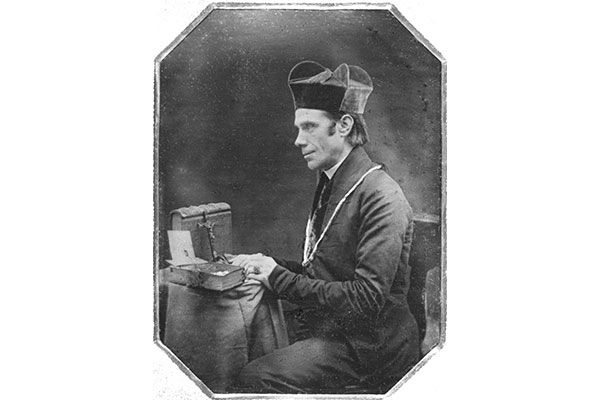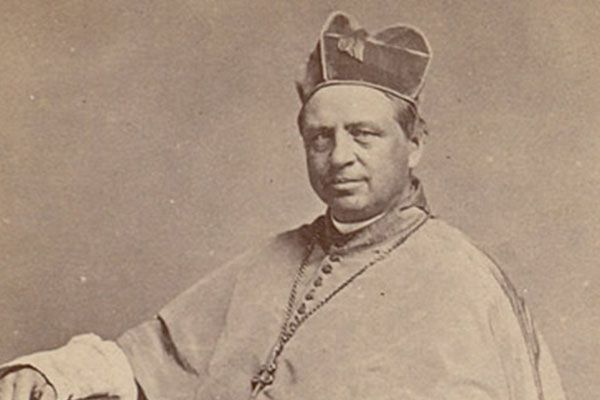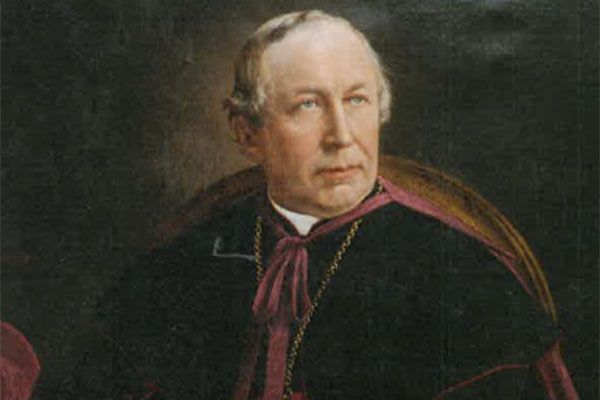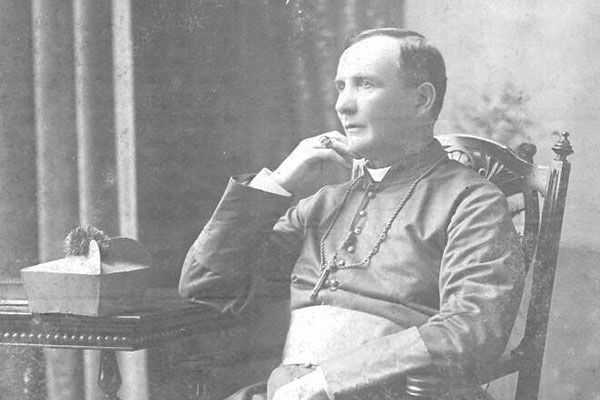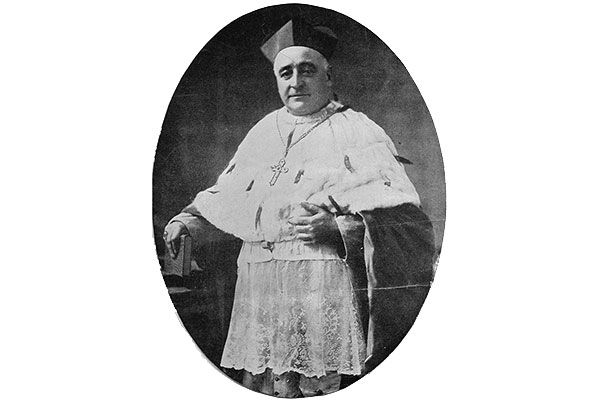Most Rev. Edward Joseph McCarthy
First Archbishop from Halifax
1906-1931
Edward Joseph McCarthy was born on January 25, 1850, in Halifax, NS. He studied for the priesthood at both St. Mary’s College and the Grand Seminary of Montreal and was ordained a priest in 1874, at the age of 24 years old.
His first pastoral assignment was in Kentville 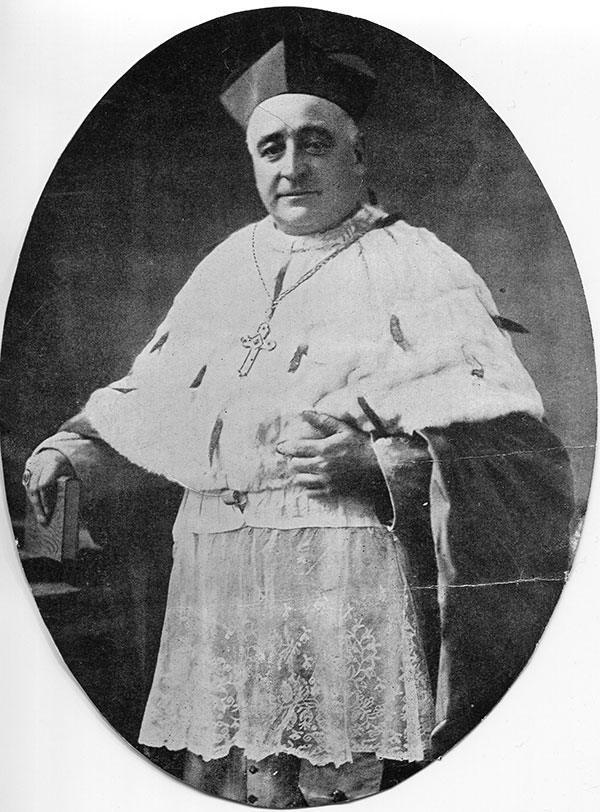 where he worked for three years before being moved to St. Augustine’s Parish in Chester. Fr. McCarthy served the parish in Chester for seven years. His position required him to travel often, as the parish held up to seven mission churches all over the south shore of Nova Scotia, including locations as far as Bridgewater and New Ross. Fr. McCarthy was then subsequently transferred to Yarmouth and lived among the Acadian population. He quickly gained fluency in French. St. Anne’s College was founded in 1891 due in part to Fr. McCarthy’s persistent advocacy for French higher education. Many Acadians admired Fr. McCarthy as much of the population had felt neglected by the Archdiocese over cultural differences with the Episcopal See in Halifax. However, some members of the Acadian community in 1908 lobbied to separate from the Archdiocese of Halifax and create their own Acadian Diocese in Moncton. Archbishop McCarthy intervened quickly and turned down the request. He believed it was a loud minority of the Acadian community who wished to separate. Archbishop McCarthy worked with the Apostolic Delegate to Canada Cardinal Donato Rafaele Sbaretti to find an agreeable compromise and the end result was to appoint a coadjutor Bishop of Acadian descent to the Diocese of Charlottetown.
where he worked for three years before being moved to St. Augustine’s Parish in Chester. Fr. McCarthy served the parish in Chester for seven years. His position required him to travel often, as the parish held up to seven mission churches all over the south shore of Nova Scotia, including locations as far as Bridgewater and New Ross. Fr. McCarthy was then subsequently transferred to Yarmouth and lived among the Acadian population. He quickly gained fluency in French. St. Anne’s College was founded in 1891 due in part to Fr. McCarthy’s persistent advocacy for French higher education. Many Acadians admired Fr. McCarthy as much of the population had felt neglected by the Archdiocese over cultural differences with the Episcopal See in Halifax. However, some members of the Acadian community in 1908 lobbied to separate from the Archdiocese of Halifax and create their own Acadian Diocese in Moncton. Archbishop McCarthy intervened quickly and turned down the request. He believed it was a loud minority of the Acadian community who wished to separate. Archbishop McCarthy worked with the Apostolic Delegate to Canada Cardinal Donato Rafaele Sbaretti to find an agreeable compromise and the end result was to appoint a coadjutor Bishop of Acadian descent to the Diocese of Charlottetown.
In 1898 he returned to Halifax and was promoted to Pastor of St. Patrick’s Church. Later that year he was appointed Rector of St. Mary’s Cathedral succeeding Monsignor Edward Murphy after his death. Fr. McCarthy remained the Rector of the Cathedral until he succeeded Archbishop Cornelius O’Brien in 1906 following O’Brien’s death. Archbishop Edward Joseph McCarthy was consecrated at St. Mary’s Cathedral on September 9th, 1906, by Cardinal Sbaretti. He was the first Bishop of the Archdiocese of Halifax born and raised in Halifax. Interestingly Archbishop McCarthy was baptized in the same Cathedral in 1850. Shortly before his consecration in 1906 St. Francis Xavier University bestowed unto him an Honorary Doctor of Laws for his knowledge and passion of Canon Law.
Archbishop McCarthy’s episcopacy proved to be busy. Early on in his episcopate the Canadian Bishops with consultation from the Vatican established the First Plenary Council of Canada in 1909. The Council was a synod of all the Canadian bishops that took place in Quebec City for six weeks starting on September 19 of that year. Before the Council met Cardinal Sbaretti recommended to the Council that Archbishop McCarthy lead the proceedings. This never came to fruition. The results of the Council were officially published in June of 1912 and included a nationwide Pastoral letter and 688 conciliar decrees. The Council also agreed to meet regularly in the future.
In February 1910 Archbishop McCarthy met with local Catholics at his residence on Dresden Row. They discussed the need for improved catechesis to defend against growing anti-Catholic arguments. The result of this meeting was the formation of the Halifax branch of the Catholic Truth Society. The Halifax Truth Society published several pamphlets that promoted Catholic apologetics and were funded in part by funds bequeathed by prominent local Catholic Thomas Flinn. Among the society’s most avid supporters and members was the Honorable Nicholas H. Meagher who was a retired Supreme Court of Nova Scotia Judge and a Knight Commander of the Order of St. Gregory. Meagher in promotion of the society stated “It is regrettable but known fact that many Catholics are afraid or ashamed to announce their faith in the presence of non-Catholics, several reasons might be attributed to this want of courage and of loyalty: but the most plausible explanation seems to be a lack of understanding in the principles and history of the Church.” The Society felt that the promotion of Catholic works may address the level of timidity in the community.
During WWI, ArchbishopMcCarthy experienced challenges in managing priest assignments due to the need for military chaplains. In 1916 during the height of the war the Archdiocese had 55,000 Catholics and 49 diocesan priests, the lowest of any diocese in the Maritimes. The Archdiocese was stretched thin as to how many priests they could provide for the war effort in some cases some rural parishes in the Archdiocese were without permanent priests for the duration of the war. The Bishops of Canada worked together to recruit chaplains for the war effort and also tried to ensure that no diocese was too depleted of Priests at home. In total 90 Catholic Priests from Canada served as Chaplains during World War I and miraculously none were killed and only 6 sustained serious injuries.
On December 6, 1917, Archbishop McCarthy 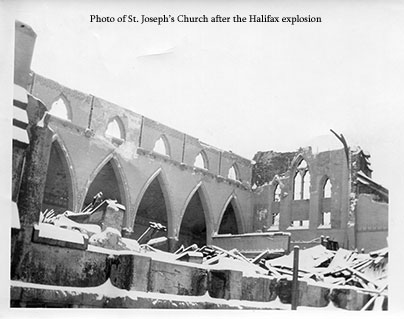 witnessed the terrible and tragic events of the Halifax explosion, which resulted in nearly 2,000 deaths, countless injuries, and millions of dollars in property damage. Many Catholic institutions and churches were destroyed because of the explosion such as St. Joseph’s Church. St. Joseph’s Convent and School also sustained severe damage and casualties. St. Mary’s Cathedral sustained damage to the roof, cracks to the bells and its priceless stained-glass windows were destroyed. Much of Halifax was left homeless and bereaved. A snowstorm rocked the city for 2 days causing difficulties in the search and rescue efforts. Archbishop McCarthy took several decisive actions to assist the city. He recalled priests from rural parishes to Halifax to administer to the grieving and the injured. He also implored the people of Halifax to provide accommodation for the homeless. Archbishop McCarthy along with the five Suffragan Bishops of the Maritimes sent an appeal to Prime Minister Sir. Robert Borden days later. The letter called for the Federal government to take decisive action, supply relief and cover some of the costs of the damage. The Federal Government agreed to the conditions and sent $30 million dollars in relief to Halifax. A further $10 million was provided through foreign aid. The government of Massachusetts was very generous in donating medical supplies, clothes, and blankets. The Archbishop published a pastoral letter in February addressing the suffering of the people of Halifax, which brought much comfort to the faithful.
witnessed the terrible and tragic events of the Halifax explosion, which resulted in nearly 2,000 deaths, countless injuries, and millions of dollars in property damage. Many Catholic institutions and churches were destroyed because of the explosion such as St. Joseph’s Church. St. Joseph’s Convent and School also sustained severe damage and casualties. St. Mary’s Cathedral sustained damage to the roof, cracks to the bells and its priceless stained-glass windows were destroyed. Much of Halifax was left homeless and bereaved. A snowstorm rocked the city for 2 days causing difficulties in the search and rescue efforts. Archbishop McCarthy took several decisive actions to assist the city. He recalled priests from rural parishes to Halifax to administer to the grieving and the injured. He also implored the people of Halifax to provide accommodation for the homeless. Archbishop McCarthy along with the five Suffragan Bishops of the Maritimes sent an appeal to Prime Minister Sir. Robert Borden days later. The letter called for the Federal government to take decisive action, supply relief and cover some of the costs of the damage. The Federal Government agreed to the conditions and sent $30 million dollars in relief to Halifax. A further $10 million was provided through foreign aid. The government of Massachusetts was very generous in donating medical supplies, clothes, and blankets. The Archbishop published a pastoral letter in February addressing the suffering of the people of Halifax, which brought much comfort to the faithful.
To read more about the Halifax explosion, please see our virtual exhibit HERE.
Sister Mary Szostak with a Slavic immigrant at Pier 21 in Halifax, 1930. sistersofservice.ca/pier-21
Archbishop McCarthy made support for newly arriving immigrants one of his key priorities in the decade following WWI. He stationed a Priest at the Halifax docks to welcome the newcomers and often raised funds for new immigrants. In 1925 Archbishop McCarthy approved the request by the local Catholic Women’s League to welcome 3 Sisters of Service to Halifax. The sisters spoke multiple languages including Polish and Hungarian and assisted in everything from greeting the new immigrants at the ports, translating, and assisting with Immigration paperwork, and helped with relocation. The Sisters were supported financially by the CWL and were bequeathed the home of Judge Nicholas H. Meagher on Morris Street for accommodation. Archbishop McCarthy was also the Vice-President of the Catholic Emigration Association of Canada, which helped Catholic immigrants stay connected to their faith and help them settle in communities that spoke their language.
St. Mary’s Cathedral celebrated its centennial anniversary on December 15, 1920. The celebrations included a special Mass that hosted many visiting bishops and priests. Unfortunately, many bishops and cardinals had to cancel their plans due to the winter weather, or in the case of Cardinal Begin his advanced age. All, however, sent kind congratulatory letters to the Archbishop. Monsignor William Foley published a history of the church which included a commemorative ode by Dr. John Daniel Logan, a devout Catholic WWI Sergeant. The event included the unveiling of an honorary memorial tablet for the fallen soldiers of WWI and a luncheon.
Four years later Archbishop McCarthy had another large celebration at St. Mary’s Cathedral as he celebrated his 50th anniversary of ordination to the Priesthood. 125 Priests and 5 Bishops attended the event.
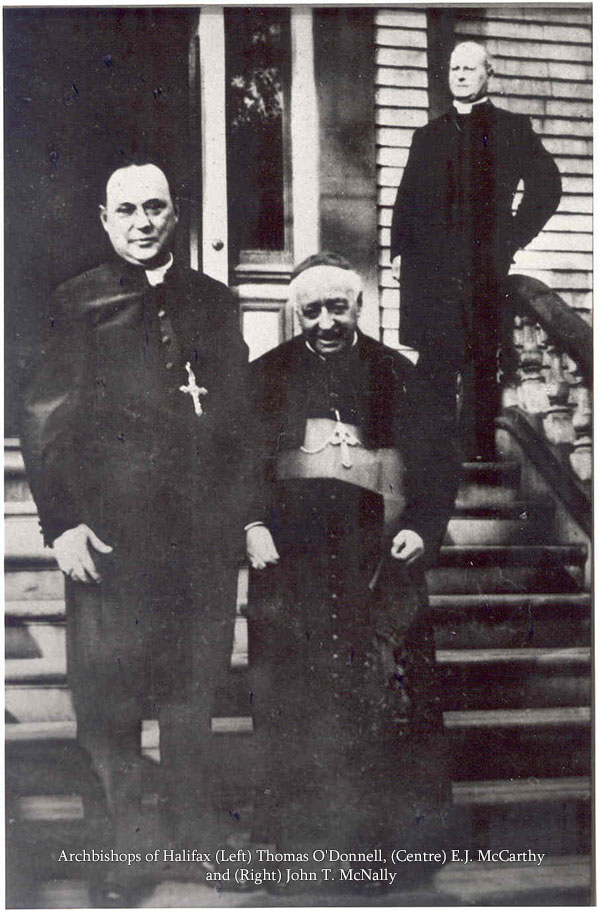 Like many of Archbishop McCarthy’s predecessors' education was an issue of particular importance. St. Mary’s University desperately needed a resolution to its teaching problem and low enrollment. Archbishop McCarthy established connections with the order of the Irish Christian Brothers and proposed to them that they take over the affairs of the university. In 1914 the order and the Archbishop signed a 60-year lease making the order solely responsible for the University. Senator Lawrence Geoffrey Power, the son of Patrick Power, was pleased enough with the decision that he finally released the funds from his father's estate that had been promised to the University several decades before. St. Mary’s University blossomed as a result of these changes. Before the order arrived, the University had only 53 students and by the time the order left in 1937, it had reached 300 students.
Like many of Archbishop McCarthy’s predecessors' education was an issue of particular importance. St. Mary’s University desperately needed a resolution to its teaching problem and low enrollment. Archbishop McCarthy established connections with the order of the Irish Christian Brothers and proposed to them that they take over the affairs of the university. In 1914 the order and the Archbishop signed a 60-year lease making the order solely responsible for the University. Senator Lawrence Geoffrey Power, the son of Patrick Power, was pleased enough with the decision that he finally released the funds from his father's estate that had been promised to the University several decades before. St. Mary’s University blossomed as a result of these changes. Before the order arrived, the University had only 53 students and by the time the order left in 1937, it had reached 300 students.
In 1929 the Archbishop’s health was failing so he appointed Thomas O’Donnell, the Irish Bishop of the Diocese of Victoria, to be his coadjutor. Bishop O’Donnell was tasked with managing the Chancery of the Archdiocese as he had a strong background in finance.
Archbishop Edward Joseph McCarthy passed awayon January 26, 1931, the day after his 81st birthday. He witnessed many things in his 24-year episcopate. He had lived through the devastation of the Great War and the Halifax explosion, oversaw the development of the Truth Society and the Catholic Emigration Association, and was honored enough to have had Papal audiences with both Saint Pope Pius X and Pope Pius XI in Rome. His funeral like many of the important events in his life was held at St. Mary’s Cathedral on January 30th, 1931. Many visiting bishops and priests attended to pay their respects and the mass was celebrated by Bishop Edouard Leblanc of the Diocese of St. John and the homily was given by the Bishop of Antigonish and McCarthy’s friend Bishop James Morrisson.
References
Archbishop E.J. McCarthy Fonds. “Chaplains.” Archdiocese of Halifax-Yarmouth Archives, (Volume II, 127-128A). 1916-1918.
Archbishop E.J. McCarthy Fonds. “College Federation.” Archdiocese of Halifax-Yarmouth Archives, (Volume II, 167-192). 1922-1929.
Archbishop E.J. McCarthy. “Obituary” Nova Scotia Public Archives, Vol. 181 no. 9, Manuscript #256. January 26th, 1931.
Archbishop E.J. McCarthy Fonds. “St. Mary’s Cathedral Celebrations.” Archdiocese of Halifax-Yarmouth Archives, (Volume IV, 330-330A). 1920-1921.
Cardinal, Sbaretti, Donato. Letter from Cardinal Donato Sbaretti to Archbishop Edward Joseph McCarthy. Ottawa, ON, May 18th, 1909. Archdiocese of Halifax-Yarmouth Archives.
Cardinal, Sbaretti, Donato. Two Letters from Cardinal Donato Sbaretti to Archbishop Edward Joseph McCarthy. Ottawa, ON, February 12th-22nd, 1910. Archdiocese of Halifax-Yarmouth Archives.
Catholic Register Staff. “A glimpse of the faith, courage of Canada, Courage of Canada’s WWI army chaplains.” The Catholic Register Digitial Archives. October 31st, 1918.
https://www.catholicregister.org/item/28402-the-register-archives-a-glimpse-of-the-faith-courage-of-canada-s-wwi-army-chaplains
Cheney, David M. “Archbishop Edward Joseph McCarthy.” Catholic Hierarchy. February 25th, 2024. https://www.catholic-hierarchy.org/bishop/bmccej.html
Foley, Fr. William. The Centenary of St. Mary’s Cathedral, 1820-1920: Souvenir Memoir. Halifax, NS. John L. Connolly, 1920. Nova Scotia Public Archives.
Hanington, J. Brian. Every Popish Person: The Story of Roman Catholicism in Nova Scotia and the Church of Halifax, 1604-1984. Archdiocese of Halifax, 1984, pg. 168-195.
McCall, Samuel Walker. Report of the Halifax Relief Expedition. Boston, MA: Wright and Potter Printing Company, 1918. Archdiocese of Halifax-Yarmouth Archives.
McCarthy, Archbishop Edward Joseph. Pastoral Letter to Archdiocese of Halifax Parishes. Halifax, NS, February 7th, 1918. Archdiocese of Halifax-Yarmouth Archives.
Morrisey, Francis G. “The Development of Ecclesiastical Particular Law in Canada.” Société Canadienne D'histoire de l'Église Catholique, Volume 50, No. 1 (1983): pg. 141-158.
https://www.erudit.org/fr/revues/sessions/1983-v50-n1-sessions1827479/1007040ar.pdf
Rev. A. McIsaac. “Baptism Certificate for Edward Joseph McCarthy.” St. Mary’s Cathedral, January 29th, 1850. Archdiocese of Halifax-Yarmouth Archives.
Schmeltzer, Catherine. “Sisters of Service in community work.” The Mail-Star. May 27th, 1972. Archdiocese of Halifax-Yarmouth Archives.
Archives Contact
Sharon Riel
Archivist - Halifax Office
Archdiocese of Halifax - Yarmouth
(902) 429-9800 ext 314
